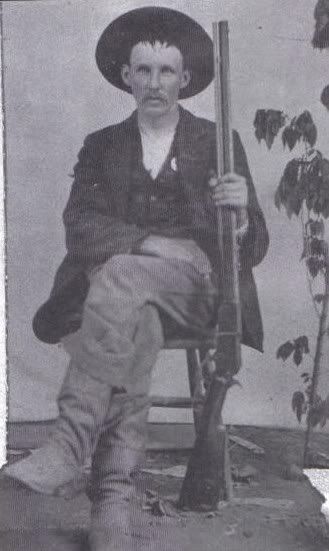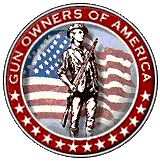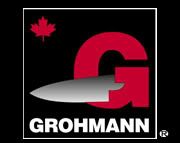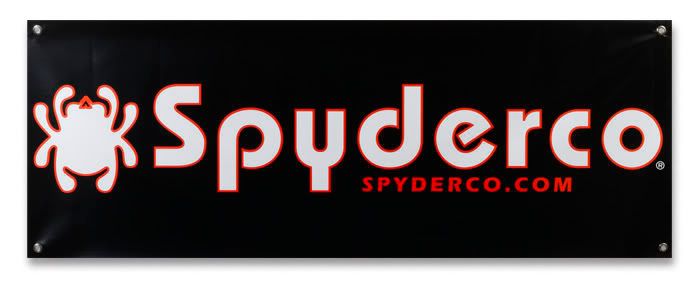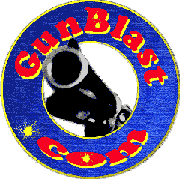They are few and far between, these bolt-action guns that I actually like. Oh, I'll shoot all of them, I pick them up and look them over and check them out this way and that but I won't spend money on most of them.
The only centerfire bolt guns I really like to the point that I'll spend money on them are the Lee-Enfields and derivatives and the M1891 Mauser. I'll bet some of you are shaking your heads, wondering why I like that old stuff or perhaps if I've never heard of the Winchester M70 or Remington 700 and why I could ignore those wonders of the western world for an overweight, rear-locking or single-column magazine bolt gun.
My first bolt-action gun chambered to anything impressive was a Mauser M91 rifle that had been bubba-ized. The barrel had been cut back to about 21", the issue rear sight removed, the stock "bleached" and refinished probably with Tru-Oil, Weaver mounts had been "installed", the Mauser wing safety had a steel rod soldered to it as an extension to make it operable with the scope (cheap is all I remember) installed. Pretty much an abomination. I'm sure Dad was rolling his eyes behind my back and praying for God to give me some commonsense! I stripped the gun apart, removed the safety "extension", had Jon Ritenour of Homstead Gun Shop in Harrisonburg, VA drill and tap the action for a Williams Foolproof Receiver Sight and install a ramp front with post (I think this was a take off from a Remington rifle of some type). I then ordered a stock from Reinhart Fajen and put it all together. This was a pretty good gun.
If I remember correctly I loaded 43 gr. of IMR 4064 under the Hornady 174 gr. .311" RN. Brass was EXPENSIVE and I had no idea that I could form my own from cheap .30-06. I think I paid $20+ a box of twenty Norma cases in 1973! I've no idea what velocity I was getting but I was certain I had elk medicine. In fact, when in California, I took it north to visit a friend stationed at FT Lewis for just such an eventuality. It never did shoot an elk though. That rifle sadly left my hands during the big D in 1984 but I kept the dies, ammo, and other components "just in case". As is usual, the "just in case" came to pass albeit nearly 15 years later.
I'd been helping a fellow soldier and shooter load for his odd stuff like .30-40 Krag and he'd bought an 1891 Engineer's carbine. Based on that I gave him dies, brass and ammo I had. After 15 years I'd given up on getting one myself. A couple of years after that he ups and gives me the rifle AND returns my ammo, dies, etc.! What a friend! These carbines and the cavalry carbines from which they are derived aren't that intimidating to shoot, my sporterized '91 weighed less, and they have a certain air about them.
The other bolt-action I like is the Lee-Enfield. Now, I have to admit I like the whole series and which one I might own isn't that important to me. However, when they were being mass-marketed here in the States about 1990, I bought two (2). The first was a Long Branch No. 4 MK I* and the second was a Fazerkly No. 4 MK I. Both had been FTRed and both had the milled adjustable rear sight. I later got bayonets and web slings for both. Of course, using these I was able to talk a buddy of mine into getting one of the last from Roses (a local department store, now departed) for $60. We took these guns and that good Greek HXP mil-surp ammo out for a shoot and could easily keep all the rounds on the E type silhouette at 600 yards. My buddy deliberately head-shot a doe at a measured and witnessed 140 yards with his gun. Mine have not been hunting or at least on a successful hunt. Certainly the cartridges are up to the challenge.
Actually, one can think of the 7.65x53mm Argentine (or Belgian) round as a sort of modern, rimless version of the .303 British. Ballistics are VERY similar and the same bullets and powders will work in both. Loads aren't quite the same due to the slight differences in case capacity. Both cartridges started life with 215 gr. bullets and I have loaded some of the 215 gr. Woodleighs up for my little Argentine carbine. At the original velocities they do indeed shoot to the sights. However, the hotter 150s do as well. Perhaps this is why Argentina never changed the sights. Of course the No. 4s were made for the 174 gr. ball and they shoot to the sights with that and the Sierra 180s loaded to 2400 fps.
Great guns despite their age and great cartridges that can still do the job.
Friday, July 28, 2006
Monday, July 24, 2006
Xavier puts us on to Jim March's Revolver Checkout
If you're going to buy a used revolver you need to use the Jim March Checkout (as well put as I've ever seen the various steps with rationale included!). Thanks Xavier!
Now go out there and buy a good used revolver!
Revolver checkout: how to tell if a particular specimen is any good
So you're buying a revolver. New, used, doesn't matter, you want a good one, right?
How do check one over without firing it, right at the dealer's counter or gun show table?
This is how. All of this works with DA or SA wheelguns..."close the action" on most DAs means swing the cylinder in, on SA types, close the loading gate, on breakopens, close 'em. UNLOADED.
WARNING: most of these tests require violation of the "finger off trigger" rule. Therefore, be extremely careful about safe muzzle direction and making sure the gun is unloaded ahead of time, PERSONALLY, as you begin handling it.
Note: bring a small flashlight, something small and concentrated. A Photon or similar high-powered LED light is perfect. You also want feeler gauges if you're not used to eyeballing cylinder gaps; at a minimum, bring a .002", .004" and .006".
Note2: no dry firing is required or desired at any point. It just pisses off the gun's current owner.
Cylinder play.
1) With the gun UNLOADED (check for yourself!), close the action.
2) Thumb the hammer back, and while pulling the trigger, gently lower the hammer all the way down while keeping the trigger back - and KEEP holding the trigger once the hammer is down. (You've now put the gun in "full lockup" - keep it there for this and most other tests.)
3) With the trigger still back all the way, check for cylinder wiggle. Front/back is particularly undesirable; a bit of side to side is OK but it's a bad thing if you can wiggle it one way, let go, and then spin it the other way a fraction of an inch and it stays there too. At the very least, it should "want" to stop in just one place (later, we'll see if that place is any good). The ultimate is a "welded to the frame" feeling.
Cylinder gap
4) Still holding the trigger at full lockup, look sideways through the barrel/cylinder gap. If you can get a credit card in there, that ain't good...velocity drops rapidly as the gap increases. Too tight isn't good either, because burnt powder crud will "fill the gap" and start making the cylinder spin funky. My personal .38 snubbie is set at .002, usually considered the minimum...after about 40 shots at the range, I have to give the front of the cylinder a quick wipe so it spins free again. I consider that a reasonable tradeoff for the increased velocity because in a real fight, I ain't gonna crank 40 rounds out of a 5-shot snub .
If you're eyeballing it, you'll have to hold it up sideways against an overhead light source.
SAFETY WARNING: This step in particular is where you MUST watch your muzzle direction. Look, part of what's happening here is that you're convincing the seller you know your poop . It helps the haggling process. If you do anything unsafe, that impression comes completely unglued.
Timing
5) You really, REALLY want an unloaded gun for this one. This is where the light comes in. With the gun STILL held in full lockup, trigger back after lowering the hammer by thumb, you want to shine a light right into the area at the rear of the cylinder near the firing pin. You then look down the barrel . You're looking to make sure the cylinder bore lines up with the barrel. Check every cylinder - that means putting the gun in full lockup for each cylinder before lighting it up.
You're looking for the cylinder and barrel holes to line up perfectly, it's easy to eyeball if there's even a faint light source at the very rear of both bores. And with no rounds present, it's generally easy to get some light in past where the rims would be.
Bore
(We're finally done with that "full lockup" crap, so rest your trigger finger. )
6) Swing the cylinder open, or with most SAs pull the cylinder. Use the small flashlight to scope the bore out. This part's easy - you want to avoid pitting, worn-out rifling, bulges of any sort. You want more light on the subject than just what creeps in from the rear of the cylinder on the timing check.
You also want to check each cylinder bore, in this case with the light coming in from the FRONT of each hole, you looking in from the back where the primers would be. You're looking for wear at the "restrictions" at the front of each cylinder bore. That's the "forcing cone" area and it can wear rapidly with some Magnum loads. (Special thanks to Salvo below for this bit!)
Trigger
7) To test a trigger without dry-firing it, use a plastic pen in front of the hammer to "catch" it with the off hand, especially if it's a "firing pin on the hammer" type. Or see if the seller has any snap-caps, that's the best solution. Flat-faced hammers as found in transfer-bar guns (Ruger, etc) can be caught with the off-hand without too much pain .
SA triggers (or of course a DA with the hammer cocked) should feel "like a glass rod breaking". A tiny amount of take-up slack is tolerable, and is common on anything with a transfer bar or hammerblock safety.
DA triggers are subjective. Some people like a dead-smooth feel from beginning of stroke to the end, with no "warning" that it's about to fire. Others (myself included) actually prefer a slight "hitch" right at the end, so we know when it's about to go. With that sort of trigger, you can actually "hold it" right at the "about to fire" point and do a short light stroke from there that rivals an SA shot for accuracy. Takes a lot of practice though. Either way, you don't want "grinding" through the length of the stroke, and the final stack-up at the end (if any) shouldn't be overly pronounced.
Detecting Bad Gunsmithing:
8) OK, so it's got a rock-solid cylinder, a .002" or .003" gap, and the trigger feels great. Odds are vastly in favor of it being tuned after leaving the factory.
So was the gunsmith any good?
First, cock it, then grab the hammer and "wiggle it around" a bit. Not too hard, don't bang on it, but give it a bit of up/down, left/right and circular action with finger off trigger and WATCH your muzzle direction.
You don't want that hammer slipping off an overly polished sear. You REALLY don't want that . It can be fixed by installing factory parts but that'll take modest money (more for installation than hardware costs) and it'll be bigtime unsafe until you do.
The other thing that commonly goes wrong is somebody will trim the spring, especially coil springs. You can spot that if you pull the grip panels, see if the spring was trimmed with wire cutters. If they get too wild with it, you'll get ignition failures on harder primers. But the good news is, replacement factory or Wolf springs are cheap both to buy and have installed.
There's also the legal problems Ayoob frequently describes regarding light triggers. If that's a concern, you can either swap back to stock springs, or since you bought it used there's no way to prove you knew it was modified at all .
In perspective:
Timing (test #5) is very critical...if that's off, the gun may not even be safe to test-fire. And naturally, a crappy barrel means a relatively pricey fix.
Cylinder gap is particularly critical on short-barreled and/or marginal caliber guns. If you need every possible ounce of energy, a tight gap helps. Some factory gaps will run as high as .006"; Taurus considers .007" "still in spec" (sigh). You'll be hard-pressed to find any new pieces under .004" - probably because the makers realize some people don't clean 'em often (or very well) and might complain about the cylinder binding up if they sell 'em at .002".
The guns in a dealer's "used pile" are often of unknown origin, from estate sales or whatever. Dealers don't have time to check every piece, and often don't know their history. These tests, especially cyliner gap and play, can spot a gun that's been sent off for professional tuning...like my snubbie, the best $180 I ever spent .
As long as the gun is otherwise sound (no cracks, etc) a gunsmith can fix any of this. So these tests can help you pick a particularly good new specimen, or find a good used gun, or help haggle the price down on something that'll need a bit of work.
Hope this helps.
Jim
Now go out there and buy a good used revolver!
Sunday, July 23, 2006
Is there Really a use for the Hollow-handled Knife?
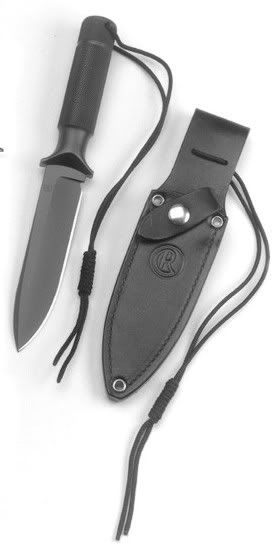 I've got a Chris Reeve Shadow IV but can't imagine what I'd put in the handle. Money, gold? Ain't got it to leave in a knife. Fishing gear, ID, metal match? Photo of my wife, kids, me? What do you put in your hollow handled knife?
I've got a Chris Reeve Shadow IV but can't imagine what I'd put in the handle. Money, gold? Ain't got it to leave in a knife. Fishing gear, ID, metal match? Photo of my wife, kids, me? What do you put in your hollow handled knife?I suppose that I can wait for an answer, my knife has journeyed to Alaska and Rob Leahy at Simply Rugged for a pancake sheath like that provided for the Shadow III. We had discussed a Scandinavian type pouch sheath but I think the knife is just too heavy for such carry. It would bother me, I think, to have that much metal just banging about.
Of course, he's a joker, he had to give me some guff about taking the knife on a recent fishing trip and losing it overboard. I didn't believe him (it would have arrived AFTER he left on the trip), but after reading about how a fellow lost a customized 1917 revolver overboard I'm a bit queasy! Did I mention that I've got to get that lanyard loop main spring housing installed on my 1991A1?
Saturday, July 22, 2006
Gunshow Field Guide
Poking about the web today I've found a treasure trove of fun stuff. Included is this Field Guide to Gun Shows. Might be too close to the truth for some readers...
Found a New-to-me Blog w/serious Info for Californians
Arms and the Law has an article from 17 July, "Heads up for Californians". If you are a Californian and you own a semi-auto firearm, you had best read this article.
Friday, July 21, 2006
What is a Great Hunter?
There are two ways that one could look at the term "great hunter". #1 that comes to most people's minds is, "great finder and killer of all things wild." I don't know that that is my idea of a great hunter. It certainly doesn't make for a fun hunting buddy. And that is pretty much the gist of the #2 version of "great hunter" as a great person with whom to hunt.
To my mind there are several things that are part of being a great hunter but not necessarily a great hunting companion (in no particular order):
- Ability to find game when and where wanted/needed.
- To take game without artificial scents/camouflage/mechanical travel aids.
- To take game cleanly with the weapon used.
- To adhere to applicable law/regulation AND moral code.
I think that in that last is the rub as the moral/ethical code of hunting varies somewhat by region and affects, to at least some degree, law and regulation. Also included in ethics is the utilization of that game. Again, in some areas what is considered game is considered a nuisance species. E.g. I will never criticize anyone for not consuming their groundhog kills. Neither will I second guess the edibility of any game meat. That's for the consumer/cook! Of course one might also add that a great hunting companion has to be forgiving my faults and errors!
Ability to find game when and where wanted/needed. Let's face it. To be considered one of the all time great hunters, those skilled in finding and killing game, you have to be able to find game pretty much on demand. Certainly there will be times when that's impossible but nobody is going to think in terms of "great hunter" if it takes 10 years to get a deer! This means that the great hunter (and hunting companion) is knowledgeable about game behaviors & hunting area topography, and can put them together to know when and where the game is most likely to be.
To take game without artificial scents/camouflage/mechanical travel aids. Can the hunter fill his bag while eschewing all the scents, baits, scent hiding and camouflage clothing? Can the hunter walk or ride a horse to his hunting location and, just as importantly, bring the game out the same way? Or does the hunter need a four wheel ATV, with multiple radios for the group and a GPS to find his way to the outhouse? A great hunter can do without such things and still be successful.
To take game cleanly with the weapon used. I'm not big on getting down on the users of particular tools. What one uses for hunting is a personal preference. One could come to that preference due to physical limitation, family tradition, personal interest, or for the challenge. Perhaps all of these factors are weighed, consciously or not, in the final choice of hunting arm. However, how well one uses that arm be it club, knife, spear, bow, or gun is important. As a companion, I want to know that you aren't going to endanger MY life with your handling of your chosen tool. For the killer of game, it is a given that one must be able to use the chosen arm with dexterity!
To adhere to applicable law/regulation AND moral code. It should be easy enough to read and understand the laws and regulations governing hunting. One should have an ethical model which one can follow. But the great hunter can resolve the differences between the two (and there will be differences) so that he rises above the normal hunter and exploits the rules without violating his ethics. In the case of the hunting partner, those ethics pretty much need to the be SAME as yours. If they aren't the two of you just won't get along.
The thing is that the ethics of the hunt vary by region. Baiting, hunting with dogs, use of vehicles, party shooting (where any hunter or hunters may kill game not to exceed the limit for the group), Sunday hunting and so forth may be considered both legal and ethical in one area but not in another. Understanding and adapting to the local conditions is part of what a great hunter has to do.
Still, I find that many, many hunters (contrary to their portrayal by the media and PETA types) place the ethics of their activity as the most important aspect of a hunter that determines his greatness.
To my mind there are several things that are part of being a great hunter but not necessarily a great hunting companion (in no particular order):
- Ability to find game when and where wanted/needed.
- To take game without artificial scents/camouflage/mechanical travel aids.
- To take game cleanly with the weapon used.
- To adhere to applicable law/regulation AND moral code.
I think that in that last is the rub as the moral/ethical code of hunting varies somewhat by region and affects, to at least some degree, law and regulation. Also included in ethics is the utilization of that game. Again, in some areas what is considered game is considered a nuisance species. E.g. I will never criticize anyone for not consuming their groundhog kills. Neither will I second guess the edibility of any game meat. That's for the consumer/cook! Of course one might also add that a great hunting companion has to be forgiving my faults and errors!
Ability to find game when and where wanted/needed. Let's face it. To be considered one of the all time great hunters, those skilled in finding and killing game, you have to be able to find game pretty much on demand. Certainly there will be times when that's impossible but nobody is going to think in terms of "great hunter" if it takes 10 years to get a deer! This means that the great hunter (and hunting companion) is knowledgeable about game behaviors & hunting area topography, and can put them together to know when and where the game is most likely to be.
To take game without artificial scents/camouflage/mechanical travel aids. Can the hunter fill his bag while eschewing all the scents, baits, scent hiding and camouflage clothing? Can the hunter walk or ride a horse to his hunting location and, just as importantly, bring the game out the same way? Or does the hunter need a four wheel ATV, with multiple radios for the group and a GPS to find his way to the outhouse? A great hunter can do without such things and still be successful.
To take game cleanly with the weapon used. I'm not big on getting down on the users of particular tools. What one uses for hunting is a personal preference. One could come to that preference due to physical limitation, family tradition, personal interest, or for the challenge. Perhaps all of these factors are weighed, consciously or not, in the final choice of hunting arm. However, how well one uses that arm be it club, knife, spear, bow, or gun is important. As a companion, I want to know that you aren't going to endanger MY life with your handling of your chosen tool. For the killer of game, it is a given that one must be able to use the chosen arm with dexterity!
To adhere to applicable law/regulation AND moral code. It should be easy enough to read and understand the laws and regulations governing hunting. One should have an ethical model which one can follow. But the great hunter can resolve the differences between the two (and there will be differences) so that he rises above the normal hunter and exploits the rules without violating his ethics. In the case of the hunting partner, those ethics pretty much need to the be SAME as yours. If they aren't the two of you just won't get along.
The thing is that the ethics of the hunt vary by region. Baiting, hunting with dogs, use of vehicles, party shooting (where any hunter or hunters may kill game not to exceed the limit for the group), Sunday hunting and so forth may be considered both legal and ethical in one area but not in another. Understanding and adapting to the local conditions is part of what a great hunter has to do.
Still, I find that many, many hunters (contrary to their portrayal by the media and PETA types) place the ethics of their activity as the most important aspect of a hunter that determines his greatness.
Thursday, July 20, 2006
Finding a Rare Firearm
Wouldn't you love to find a rare firearm? Wouldn't you be excited? How would you prove the provenance on such a thing? How about having the rifle shown in the photo? The owner is Johnse Hatfield, of Hatfield/McCoy feud fame. The rifle is an 1876 Winchester, chambering and serial unknown. I've been in contact with the fellow who thinks he has this jewel but, no, I'm not telling who. I just think it is cool that there are still such things to discover.
Oh, for what its worth I think the image is reversed. Notice the lack of loading gate, with the rifle in this position it will twist to the correct orientation.
Oh, for what its worth I think the image is reversed. Notice the lack of loading gate, with the rifle in this position it will twist to the correct orientation.
Norinco M213 - Chinese Tokarev 9mm Parabellum
 I was visiting my local slobber shop one day and, fortunately for them, had some money burning a hole in my pocket. I'd been wanting a Tokarev as a sample to shoot and understand and there sat one in the case. Ok, so it was a Chinese 9mm (M213) with that dang stupid and impossible to use safety), but there it was for only $125. To seal the deal Ernie threw in an extra magazine (he had to go dig for it). Unlike the one in the first photo, mine had long ago lost the box. Now, these are selling for somewhere in the vicinity of $300-200 depending on condition.
I was visiting my local slobber shop one day and, fortunately for them, had some money burning a hole in my pocket. I'd been wanting a Tokarev as a sample to shoot and understand and there sat one in the case. Ok, so it was a Chinese 9mm (M213) with that dang stupid and impossible to use safety), but there it was for only $125. To seal the deal Ernie threw in an extra magazine (he had to go dig for it). Unlike the one in the first photo, mine had long ago lost the box. Now, these are selling for somewhere in the vicinity of $300-200 depending on condition.Now that I had the gun, I'd have to have a holster to make it useful, and for what would it be useful. How should it be carried? The "safety" is worthless, if I could fill in the holes that removing it would leave it would already be gone. Unfortunately, that isn't an option and the useless appendage remains. Again, needing leather a quick search was made of the storage box which result was the location of a US Army surplus M7 chest holster for the .38 cal revolver. A quick try and clearly, the M213 fits perfectly! Joy of joys.
Now, how about that spare magazine? After all what bottom feeder other than a .25 ACP pocket pistol is worth a fig without a spare mag? This was easily solved. Right next to the M7 was an Uncle Mikes nylon mag pouch. Threaded onto the shoulder strap of the M7 holster and I had a package of holster and mag pouch ready to go.
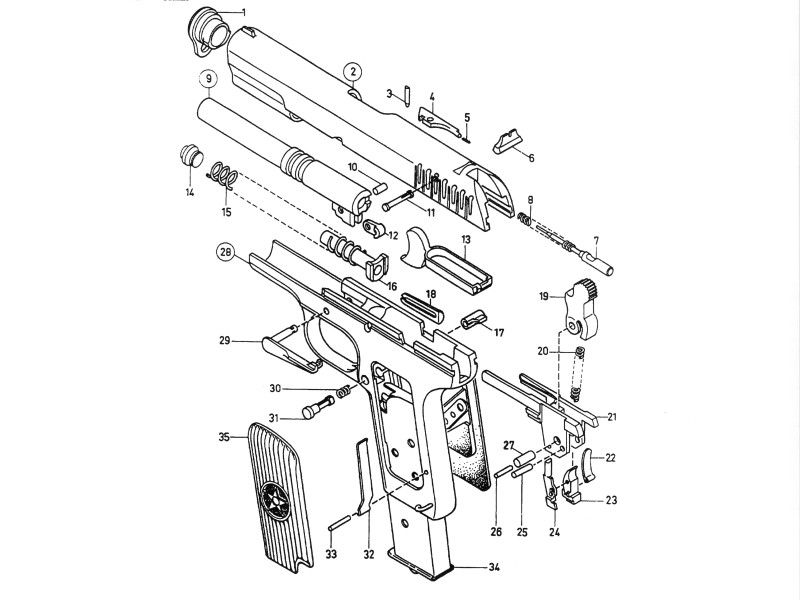 Now, back to the pistol. As any gunny type person can see in the exploded view, the Tokarev is a basic Browning design. It differs in two major ways. The first is that it has none of the "extraneous" safeties and is best carried hammer down on an empty chamber. The other major change was that the designer, Fedor Tokarev, made a removable modular hammer/sear assembly. This facilitates cleaning and field stripping without putting the smaller parts at risk of loss. Disassembly and reassembly are a snap!
Now, back to the pistol. As any gunny type person can see in the exploded view, the Tokarev is a basic Browning design. It differs in two major ways. The first is that it has none of the "extraneous" safeties and is best carried hammer down on an empty chamber. The other major change was that the designer, Fedor Tokarev, made a removable modular hammer/sear assembly. This facilitates cleaning and field stripping without putting the smaller parts at risk of loss. Disassembly and reassembly are a snap!The Chinese, as a communist client and beneficiary of Soviet design work, produced the TT-33 some of which made their way to Vietnam and, after capture, to the US. Somewhere along the way, the Chinese were convinced that producing the pistols in the world-wide popular 9mm Parabellum aka Luger or 9x19mm NATO chambering would be a sound marketing decision and did so. The M213 is one such on the theme.
No longer imported because of certain impolitic moves by the Chinese and Norinco, the M213 is typical of communist made firearms. It is functional, ugly, of uneven but complete finish with unevenly stamped maker's marks on slide and frame, and generally hell-for-stout. All these guns do have a reputation for soft metal and low service life. I've seen the service life for one of these pistols given as little as 1000 rounds! Mine has seen considerably more than that and is still going strong despite these naysayers. Perhaps I own the exception to the rule but I doubt it.
As I said before, disassembly and reassembly are easy! You might note in this link that the pistol doesn't have the safety. Don't worry, it matters not at all as nothing changes in field stripping. One simply ignores the safety (as you'll learn to do in any case). So, I got my gun apart and gave it a good cleaning.
With the gun apart, I could see then (and still do) that there was little wear. That was a good thing given some of the tall tales I'd heard. Cleaning was quick and easy and familiar since I'd cleaned a lot of M1911s.
Shooting was simple and carefree, too. Every round fed and there was quite an accumulation of assorted overall length, bullet shape, etc in my collection of 9mm ammunition. Encouraged, I took some Sellier and Belloit 9mm ball and zeroed the gun. Actually it didn't take much but to square up the notch in the rear sight which was a bit ragged. Suddenly the gun was ON for windage but, depending on the load, required a bit of elevation adjustment. As the sights on these guns are fixed, that was all the file work I cared to do.
After firing another 100 rounds I was really encouraged and went home to reload all that brass. Unfortunately, I got home to find that the gun store was closed and the only bullets on hand that had even a remote chance of working were a bulk-buy of Remington 125 gr. SJHP .357" bullets for the .38 Special and .357 Mag. Undaunted, I loaded these over a charge of Unique and headed back to the range. These worked well and shot to POA at 25 yards. Yep, those slightly oversized bullets in the 9mm case fed and shot very well without producing excessive pressures. All in all, this is a very forgiving pistol.
The safety though was not functional. Oh, you could work it after a fashion if you used both hands. Stiff doesn't describe this thing. BUT it works in the opposite direction of the M1911 safety and you can't count on being able to disengage it. Also, I think it only blocks the sear, not the hammer, and isn't as foolproof as the M1911 and descendents.
As I mentioned earlier, these pistols are now selling for something like $200-300 depending on condition and locality. So, many folks are moved to buy one as their first self-defense pistol. Nothing wrong with that, but you do have to remember a couple of things. First, do not rely on the safety. Carry the gun hammer down on an empty chamber. Use the Israeli method for fast use of this pistol in combat/self-defense situations. Basically this involves racking the slide as a part of the weapon "presentation". Clearly, one MUST keep one's finger OFF the trigger!
However, within these limitations, the gun will serve very well as a self-defense piece. It is thin, relatively light and small but uses a fairly good cartridge and has fairly good magazine capacity. The gun is more than accurate enough for use at 7 yards or less and can shoot reasonable groups to 50 yards (which is the usual maximum effective range as defined by the military).
I like my pistol at least well enough that I've yet to be moved to buy another 9x19 chambered pistol. edit - I got a Browning High Power. That's pretty good!
Special Notes: Movie on Israeli Combat Shooting, 34MB, recommend saving to HD and then viewing.
Disassembly/reassembly
Wednesday, July 19, 2006
Ruger Hard Cases
I never thought I'd be talking/writing about this subject. However, I came to be in a place where I had a couple of Rugers sans a good storage box.
One was the Ruger Speed-Six 4 inch. I have the original box but I don't want it in the safe. Other boxes plus my fiddling around in there is guaranteed to eventually destroy the box. What I needed is a good sturdy box in which I could store other similarly sized pistols or revolvers. The solution there was the MTM 804 Handgun Storage Box. This box is square, flat on top and bottom and doesn't have moisture trapping foam inside. Ideal for long-term storage of pistols and revolvers. Problem #1 solved.
Then I had my Ruger New Vaquero which came in a neat plastic box. Ruger calls this the "hard case" and sells them for $29-38. Probably costs them about $3 each. Anyway, I then got a Single-Six in a box and boy, did they stack nicely in the gun safe! Then I got the .32 H&R SSM and darn, it didn't have a box but I managed to find somebody on the Ruger forum who sold me one. Good deal I thought and loved how these boxes stacked AND protected the guns in my safe. I already had my Dad's 10" MK II, now with cardboard box. Like the Speed-Six box, this is just waiting to self-destruct as I stack other boxes on it or shuffle it with the other boxes in an attempt to extract the obsession-of-the-day. I also got a Ruger Old Army 7½". Looking at the Ruger website gave me coniptions thinking I'd have to pay 2 X $40 (including shipping) for a $3 plastic box.
Then I had the bright idea (not so bright for it to take so long) to check out the various auction sites for these boxes. Today I was lucky enough to run onto one for the Old Army 7½" at $9.99 buy-it-now. A quick click and it is done. The MO will go out tomorrow and hopefully I'll have it soon! Still need a hard case for the 10" MK II though. If you have one at a reasonable price (unlike some jokers on Gunbroker who are asking more than Ruger!), write me.
One was the Ruger Speed-Six 4 inch. I have the original box but I don't want it in the safe. Other boxes plus my fiddling around in there is guaranteed to eventually destroy the box. What I needed is a good sturdy box in which I could store other similarly sized pistols or revolvers. The solution there was the MTM 804 Handgun Storage Box. This box is square, flat on top and bottom and doesn't have moisture trapping foam inside. Ideal for long-term storage of pistols and revolvers. Problem #1 solved.
Then I had my Ruger New Vaquero which came in a neat plastic box. Ruger calls this the "hard case" and sells them for $29-38. Probably costs them about $3 each. Anyway, I then got a Single-Six in a box and boy, did they stack nicely in the gun safe! Then I got the .32 H&R SSM and darn, it didn't have a box but I managed to find somebody on the Ruger forum who sold me one. Good deal I thought and loved how these boxes stacked AND protected the guns in my safe. I already had my Dad's 10" MK II, now with cardboard box. Like the Speed-Six box, this is just waiting to self-destruct as I stack other boxes on it or shuffle it with the other boxes in an attempt to extract the obsession-of-the-day. I also got a Ruger Old Army 7½". Looking at the Ruger website gave me coniptions thinking I'd have to pay 2 X $40 (including shipping) for a $3 plastic box.
Then I had the bright idea (not so bright for it to take so long) to check out the various auction sites for these boxes. Today I was lucky enough to run onto one for the Old Army 7½" at $9.99 buy-it-now. A quick click and it is done. The MO will go out tomorrow and hopefully I'll have it soon! Still need a hard case for the 10" MK II though. If you have one at a reasonable price (unlike some jokers on Gunbroker who are asking more than Ruger!), write me.
Monday, July 17, 2006
Drive-by Shooting In Front of My House - Updated
So, I was sitting at my computer, perusing the latest posts on Leverguns.com and pop, pop, pop, pop, etc. right in front of the house. My office is in the back and has a window on the side of the house. All I can see from inside the lighted office is the black shape of a car passing the limbs of the spruce tree(s) out front and some muzzle flashes. Got the phone and Maglight and went to check it out. Cops there shortly and picked up the brass, which looked to be 9mm Luger. Witness in park thought it was a Chevy Cavalier, dark. No ID on any of the people in car or as supposed targets in park. All quiet over there now! Happened at about 10:15 PM. Not such a sleepy town anymore!
UPDATE
No report in the paper. No known follow-up by the PD. Neighbors weren't even aware of what had happened!
UPDATE
No report in the paper. No known follow-up by the PD. Neighbors weren't even aware of what had happened!
Saturday, July 15, 2006
Concealed Carry Guns
I've had my permit since 1987. I've tried all the following:
For a while I carried it in an Uncle Mikes IWB which was basically just a pocket of nylon fabric with a metal belt clip. It worked ok for me as I wasn't doing any running. However, one day, I did have to run a bit and felt it start to slip out. It was a bit awkward to reseat the revolver in that thing without being noticed. I imagine that the 2" barrel (actually shorter than that) would be worse for that.
 The Colt Junior was purchased from a friend when he needed money and returned to him for the purchase price after his father died. I carried it for a while when I first got my Concealed Handgun Permit. An ankle holster from Uncle Mike sufficed for carry but it was sometimes just dumped in a pocket. I had little faith in that system. Please note that these little pistols really do need to be carried hammer down on an empty chamber.
The Colt Junior was purchased from a friend when he needed money and returned to him for the purchase price after his father died. I carried it for a while when I first got my Concealed Handgun Permit. An ankle holster from Uncle Mike sufficed for carry but it was sometimes just dumped in a pocket. I had little faith in that system. Please note that these little pistols really do need to be carried hammer down on an empty chamber.
The little .25 Auto was clearly only suited for backup duties. I got a .45 ACP Combat Commander and relegated the .25 Auto to "back-up" duties and for carry when anything bigger was impossible. The one pictured here is not the one I owned but I preferred this photo because it showed the original box.
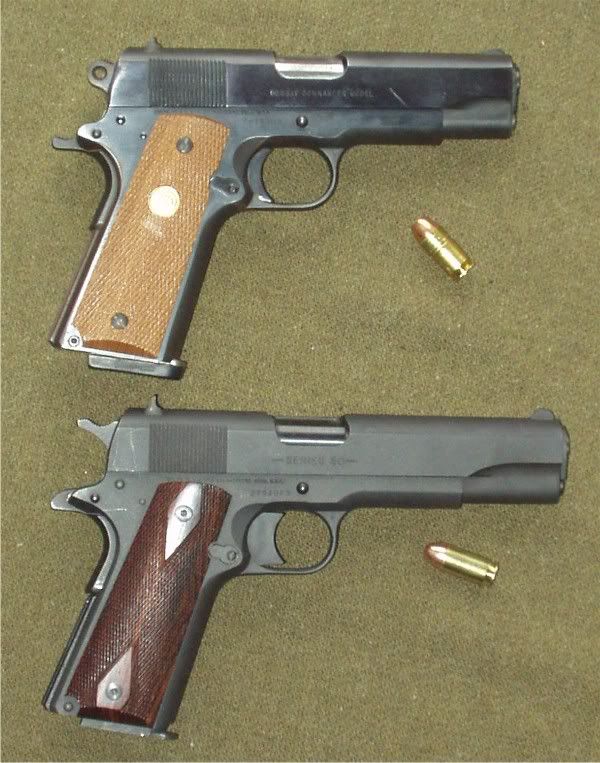 The Combat Commander and, now, the full-sized Government model are excellent carry guns. One certainly doesn't feel under-gunned! However, they aren't ideal for those with a bit more around the middle and inside the pants carry. It can be uncomfortable.
The Combat Commander and, now, the full-sized Government model are excellent carry guns. One certainly doesn't feel under-gunned! However, they aren't ideal for those with a bit more around the middle and inside the pants carry. It can be uncomfortable.
One simply can't argue with the .45 ACP cartridge. Even the FMJ stuff works and inspires confidence. That can be extremely important in states such as New Jersey that prohibit hollow-points (provided you can have the pistol in the first place).
Sometimes, perhaps always, confidence in your tool is what gets you through a difficult time. The guns also inspire a LACK of confidence on the behalf of your opposition, particularly if they know what they are facing. I had one incident in which my competence with the big, old, military pistol and the sight of it on my desk completely changed the attitude of one young man who had been determined to tell me what to do.
The Smith and Wesson M629, stainless N frame in .44 S&W Magnum, has been tried as well. Let's just say that it was a stop gap and that the revolver has just never really suited me. Even in the woods, I couldn't get completely comfortable with the gun. It will shoot well but the grips and their size relative to my hand(s) have made this revolver somewhat problematic. It is a well made gun with no mechanical worries and the .44 Mag cartridge in factory or handloaded to be much more tame is still effective as any .4something should be. I think that a physically larger fellow could handle this gun just as well as I do the Smith and Wesson M13.
The Smith and Wesson M13, blued steel 3" barrel .357 Magnum, was carried extensively. Loaded as the FBI did with the 158 gr. .38 Special FBI load or the Federal 125 gr. all-out .357 Mag load, I carried this gun pretty much all year except during winter (when the Combat Commander got the nod) for about 12 years. Well read folks won't need a description of the effectiveness of the ammunition used.
The gun itself was carried in a Bianchi Pistol Pocket, an IWB holster, and backed up with a couple of HK speed-loaders and Bianchi Speed Strips. It was a constant companion thus carried and during the summer rode undetected beneath dark colored T-shirts. Despite our hot summers and the blued steel of the gun, sweat and/or rust were not a problem.
I did go through a couple of grip options. The first was the factory grips with a Tyler T-grip adapter which worked very well but was darn uncomfortable to shoot when it was stoked with the 125 gr. screamers. For that reason I eventually switched to a set of Pachmayr Compacs as shown. This is a great gun and has always shot to POA at reasonable self-defense ranges.
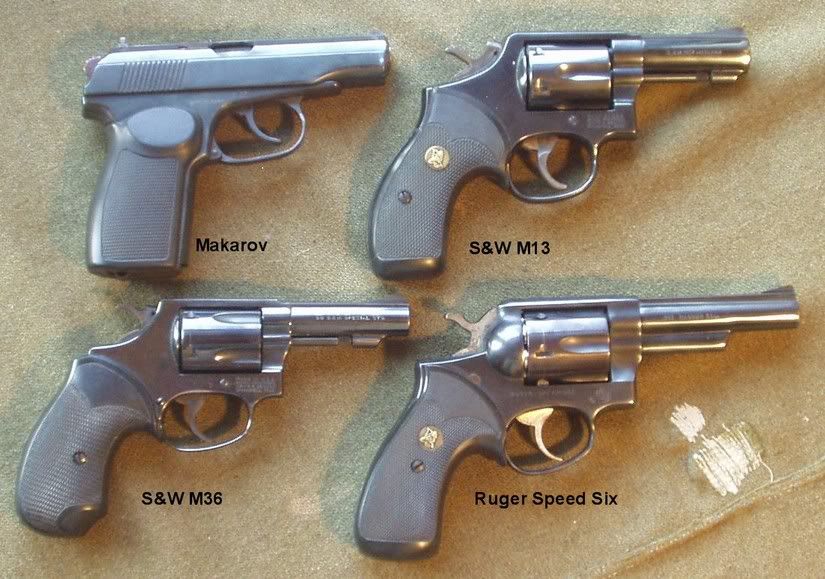 Likewise I installed the same Pachmayr Compacs on Dad's Ruger Speed-Six, 4", .357 Magnum. Using the same loads in this gun, I have tried several holsters but now leave the deep concealed carry to the M13 and carry the Speed-Six in an Uncle Mike's nylon paddle holster. If you ask me, this is THE gun to leave bedside for the wife when out of town. As Kim du Toit says, "it is like a fork, pick it up and it works." It fits the wife's hand and I think it would fit most peoples' hand just fine.
Likewise I installed the same Pachmayr Compacs on Dad's Ruger Speed-Six, 4", .357 Magnum. Using the same loads in this gun, I have tried several holsters but now leave the deep concealed carry to the M13 and carry the Speed-Six in an Uncle Mike's nylon paddle holster. If you ask me, this is THE gun to leave bedside for the wife when out of town. As Kim du Toit says, "it is like a fork, pick it up and it works." It fits the wife's hand and I think it would fit most peoples' hand just fine.
Sometimes, we just can't leave well enough alone. All of the above guns had shown me what worked but curiosity got the better of me and I purchased a Bulgarian made Pistolette Makarov in the chambering for which it was designed, the 9mm Makarov aka 9x18mm.
Large for the cartridge for which it is chambered, at least by modern standards, the Pistolette Makarov is dependable, well made (if not refined), and easy to manage. One might not like the heel type magazine release or have a problem with the trigger but both work and work well enough. The magazine holds 8 rounds and one can load one up the spout and a full mag for 9 rounds total of moderate .38 Special level power in a gun not that much different in size when compared to the 3" M36 I once carried.
I carried this gun in a heavier duty version of the IWB nylon pouch or in a Fobus paddle holster. It has yet to defend me from any two-legged vermin but has made itself available for the removal of a woodchuck. The ammo used is Barnaul's excellent steel-cased 95 gr. hollow point.
I got mine from Dan's Ammo for $60 per 500 and the good prices and excellent quality as well as reported performance keep it marked "sold out". However, if you can find it this is the best ammo to use. The FMJ stuff from Barnaul is good shooting ammo as well but I think it should be relegated to the practice role. As cheap as this stuff is, it doesn't pay to reload for this round but of course I do.
My gun is set up with a set of Pearce grips. Once you have used the issue and then the Pearce you'll never go back? These are great grips.
All this said the most important things to remember are that you must be trained, have a plan (i.e. understand under what conditions you can and will use the gun), and be responsible to the point of self-sacrifice in order to carry. Morality allows nothing less and the legal system will pursue you if you allow yourself to act in anyway less responsibly than you should.
So what do I carry now? Usually one of the 1911 based guns. If it works, don't fix it.
- S&W M36 .38 Special
- Colt Junior .25 Auto
- Colt Combat Commander .45 ACP
- S&W M629 .44 Mag
- S&W M13 .357 Mag
- Ruger Speed-Six .357 Mag
- Pistolette Makarov 9mm Makarov (9x18)
- Colt 1991A1 .45 ACP
For a while I carried it in an Uncle Mikes IWB which was basically just a pocket of nylon fabric with a metal belt clip. It worked ok for me as I wasn't doing any running. However, one day, I did have to run a bit and felt it start to slip out. It was a bit awkward to reseat the revolver in that thing without being noticed. I imagine that the 2" barrel (actually shorter than that) would be worse for that.
 The Colt Junior was purchased from a friend when he needed money and returned to him for the purchase price after his father died. I carried it for a while when I first got my Concealed Handgun Permit. An ankle holster from Uncle Mike sufficed for carry but it was sometimes just dumped in a pocket. I had little faith in that system. Please note that these little pistols really do need to be carried hammer down on an empty chamber.
The Colt Junior was purchased from a friend when he needed money and returned to him for the purchase price after his father died. I carried it for a while when I first got my Concealed Handgun Permit. An ankle holster from Uncle Mike sufficed for carry but it was sometimes just dumped in a pocket. I had little faith in that system. Please note that these little pistols really do need to be carried hammer down on an empty chamber.The little .25 Auto was clearly only suited for backup duties. I got a .45 ACP Combat Commander and relegated the .25 Auto to "back-up" duties and for carry when anything bigger was impossible. The one pictured here is not the one I owned but I preferred this photo because it showed the original box.
 The Combat Commander and, now, the full-sized Government model are excellent carry guns. One certainly doesn't feel under-gunned! However, they aren't ideal for those with a bit more around the middle and inside the pants carry. It can be uncomfortable.
The Combat Commander and, now, the full-sized Government model are excellent carry guns. One certainly doesn't feel under-gunned! However, they aren't ideal for those with a bit more around the middle and inside the pants carry. It can be uncomfortable.One simply can't argue with the .45 ACP cartridge. Even the FMJ stuff works and inspires confidence. That can be extremely important in states such as New Jersey that prohibit hollow-points (provided you can have the pistol in the first place).
Sometimes, perhaps always, confidence in your tool is what gets you through a difficult time. The guns also inspire a LACK of confidence on the behalf of your opposition, particularly if they know what they are facing. I had one incident in which my competence with the big, old, military pistol and the sight of it on my desk completely changed the attitude of one young man who had been determined to tell me what to do.
The Smith and Wesson M629, stainless N frame in .44 S&W Magnum, has been tried as well. Let's just say that it was a stop gap and that the revolver has just never really suited me. Even in the woods, I couldn't get completely comfortable with the gun. It will shoot well but the grips and their size relative to my hand(s) have made this revolver somewhat problematic. It is a well made gun with no mechanical worries and the .44 Mag cartridge in factory or handloaded to be much more tame is still effective as any .4something should be. I think that a physically larger fellow could handle this gun just as well as I do the Smith and Wesson M13.
The Smith and Wesson M13, blued steel 3" barrel .357 Magnum, was carried extensively. Loaded as the FBI did with the 158 gr. .38 Special FBI load or the Federal 125 gr. all-out .357 Mag load, I carried this gun pretty much all year except during winter (when the Combat Commander got the nod) for about 12 years. Well read folks won't need a description of the effectiveness of the ammunition used.
The gun itself was carried in a Bianchi Pistol Pocket, an IWB holster, and backed up with a couple of HK speed-loaders and Bianchi Speed Strips. It was a constant companion thus carried and during the summer rode undetected beneath dark colored T-shirts. Despite our hot summers and the blued steel of the gun, sweat and/or rust were not a problem.
I did go through a couple of grip options. The first was the factory grips with a Tyler T-grip adapter which worked very well but was darn uncomfortable to shoot when it was stoked with the 125 gr. screamers. For that reason I eventually switched to a set of Pachmayr Compacs as shown. This is a great gun and has always shot to POA at reasonable self-defense ranges.
 Likewise I installed the same Pachmayr Compacs on Dad's Ruger Speed-Six, 4", .357 Magnum. Using the same loads in this gun, I have tried several holsters but now leave the deep concealed carry to the M13 and carry the Speed-Six in an Uncle Mike's nylon paddle holster. If you ask me, this is THE gun to leave bedside for the wife when out of town. As Kim du Toit says, "it is like a fork, pick it up and it works." It fits the wife's hand and I think it would fit most peoples' hand just fine.
Likewise I installed the same Pachmayr Compacs on Dad's Ruger Speed-Six, 4", .357 Magnum. Using the same loads in this gun, I have tried several holsters but now leave the deep concealed carry to the M13 and carry the Speed-Six in an Uncle Mike's nylon paddle holster. If you ask me, this is THE gun to leave bedside for the wife when out of town. As Kim du Toit says, "it is like a fork, pick it up and it works." It fits the wife's hand and I think it would fit most peoples' hand just fine.Sometimes, we just can't leave well enough alone. All of the above guns had shown me what worked but curiosity got the better of me and I purchased a Bulgarian made Pistolette Makarov in the chambering for which it was designed, the 9mm Makarov aka 9x18mm.
Large for the cartridge for which it is chambered, at least by modern standards, the Pistolette Makarov is dependable, well made (if not refined), and easy to manage. One might not like the heel type magazine release or have a problem with the trigger but both work and work well enough. The magazine holds 8 rounds and one can load one up the spout and a full mag for 9 rounds total of moderate .38 Special level power in a gun not that much different in size when compared to the 3" M36 I once carried.
I carried this gun in a heavier duty version of the IWB nylon pouch or in a Fobus paddle holster. It has yet to defend me from any two-legged vermin but has made itself available for the removal of a woodchuck. The ammo used is Barnaul's excellent steel-cased 95 gr. hollow point.
I got mine from Dan's Ammo for $60 per 500 and the good prices and excellent quality as well as reported performance keep it marked "sold out". However, if you can find it this is the best ammo to use. The FMJ stuff from Barnaul is good shooting ammo as well but I think it should be relegated to the practice role. As cheap as this stuff is, it doesn't pay to reload for this round but of course I do.
My gun is set up with a set of Pearce grips. Once you have used the issue and then the Pearce you'll never go back? These are great grips.
All this said the most important things to remember are that you must be trained, have a plan (i.e. understand under what conditions you can and will use the gun), and be responsible to the point of self-sacrifice in order to carry. Morality allows nothing less and the legal system will pursue you if you allow yourself to act in anyway less responsibly than you should.
So what do I carry now? Usually one of the 1911 based guns. If it works, don't fix it.
Wednesday, July 12, 2006
Hatfields and McCoys Play
The play is sadly lacking in what would really sell the area, namely local music, authentic costuming and props. The houses will do but the guns and especially the blanks should be re-looked. Guns used are mostly a selection of double action revolvers, old single-shot shotguns (even for the Civil War soldiers), Winchester 1894s, and one Marlin 336. The blanks are too loud for safety. I'm a long time shooter and the initial series of blasts (very near to the audience) left my ears ringing.
The story of the Hatfield/McCoy feud itself is pretty closely followed, the girl playing Roseanne even very close in appearance. The music is another thing entirely. I wish the composer had incorporated more Appalachian music.
But of course, it was the guns that I noticed first and most disappointed me.
The story of the Hatfield/McCoy feud itself is pretty closely followed, the girl playing Roseanne even very close in appearance. The music is another thing entirely. I wish the composer had incorporated more Appalachian music.
But of course, it was the guns that I noticed first and most disappointed me.
Tamarack and Guns
I had the opportunity to visit Tamarack near Beckley, WV on I-64/I-77. The food IS very good. However, I'm more interested in, can you guess?, guns.
First, I ran into a case with a flintlock pistol by Mark Whitt of Whitt's Gun Shop, Shady Spring, WV. I thought it was very nice. Then there was a Bedford style flintlock rifle from the Horn and Antler Shop. They also had some very nice scrimmed horns. Got to love the place.
Met a fellow at the pistol case who immediately brought up the Contemporary Longrifle Association show in Lexington, KY (August 18 & 19, 2006) which he said he would attend. The wife was tugging on my shirt sleeve so I didn't get to speak with him further. Would like to know who you are so drop me a line if you will.
Anyway they also have some great scupture of frontiersmen and the usual stuff that artisans make like turned wood bowls and such. Beautiful stuff. If you ever are driving by, take a break and go on in.
First, I ran into a case with a flintlock pistol by Mark Whitt of Whitt's Gun Shop, Shady Spring, WV. I thought it was very nice. Then there was a Bedford style flintlock rifle from the Horn and Antler Shop. They also had some very nice scrimmed horns. Got to love the place.
Met a fellow at the pistol case who immediately brought up the Contemporary Longrifle Association show in Lexington, KY (August 18 & 19, 2006) which he said he would attend. The wife was tugging on my shirt sleeve so I didn't get to speak with him further. Would like to know who you are so drop me a line if you will.
Anyway they also have some great scupture of frontiersmen and the usual stuff that artisans make like turned wood bowls and such. Beautiful stuff. If you ever are driving by, take a break and go on in.
Saturday, July 08, 2006
Charles Daly High Power
45-70- on the Leverguns forum posted about the Charles Daly High Power and his desire to find out where they were built. Reading the Daly info it says
The gun looks good and certainly beats a Browning HP for cost. Davidsons shows the gun for $384.19 at the local Dominion Outdoors. That's not too terrible bad. I do wonder how much extra mags will cost...
which it implies that it is actually made in the US. I don't know, but I suspect the parts are fabricated elsewhere and assembled here in the US. This is SOP for creating "Made in USA" products particularly those as highly regulated as firearms.Made in the United States, the Daly HP is a single action 9mm pistol...
The gun looks good and certainly beats a Browning HP for cost. Davidsons shows the gun for $384.19 at the local Dominion Outdoors. That's not too terrible bad. I do wonder how much extra mags will cost...
Wednesday, July 05, 2006
Thermacell a Hit with the Hobies (with UPDATE)
 The Thermacell Mosquito Repeller Lantern is a hit with all of us in the Hobie family. It works. Might be a shade expensive but it does work.
The Thermacell Mosquito Repeller Lantern is a hit with all of us in the Hobie family. It works. Might be a shade expensive but it does work.You can get a mini-lantern for about $10, I don't know why they aren't all "minis". Walmart was about $24-26 for either the lantern or the portable model and I got a lantern anyway, it works. Got to find those butane cartridges as there is a discrepancy between burn times as advertised and in fact. They are the "Conair Cordless Curls Thermacell replacement cartridges". I should add that I don't know and don't care WHY there is such a thing as a cordless hot hair curler.
UPDATE
Found ONE source for the butane cartridges. Drugstore.com for $6.29 a pair. Shipping was fast, via UPS and FREE. Bought 4 packages or 8 cartridges this first order. Why?
Because the Thermacell really runs through these things, even at the "min" setting. Perhaps my valve isn't right but I burn 1 cell for every 1½ pads. There are 3 pads in every refill box. Do the math. However, the system is still working great for the intended use of making the unscreened back porch livable.
Saturday, July 01, 2006
My 629 or Getting a Grip on the .44
 About 1985 an officer in my Brigade had a revolver he wanted to sell. It was a Smith and Wesson M629 4" with Pachmayr Presentation grips. No box, no factory grips, but it did come with 2 boxes of reloaded ammo and a Bianchi 7L holster. I already had dies, bullets, brass, powder and a fervent desire to get a compact revolver for general use and especially, legal for deer hunting in Virginia. After the exchange of pleasantries and some money that revolver was mine.
About 1985 an officer in my Brigade had a revolver he wanted to sell. It was a Smith and Wesson M629 4" with Pachmayr Presentation grips. No box, no factory grips, but it did come with 2 boxes of reloaded ammo and a Bianchi 7L holster. I already had dies, bullets, brass, powder and a fervent desire to get a compact revolver for general use and especially, legal for deer hunting in Virginia. After the exchange of pleasantries and some money that revolver was mine.I was excited. I'd long wanted a .44 Mag of my own and had shot both Ruger Super Blackhawks and longer barreled S&W 29s. I was not intimidated by the recoil but had to admit that it was more than the .357 Magnum. Those Pachmayr Presentations really did the job on cutting recoil.
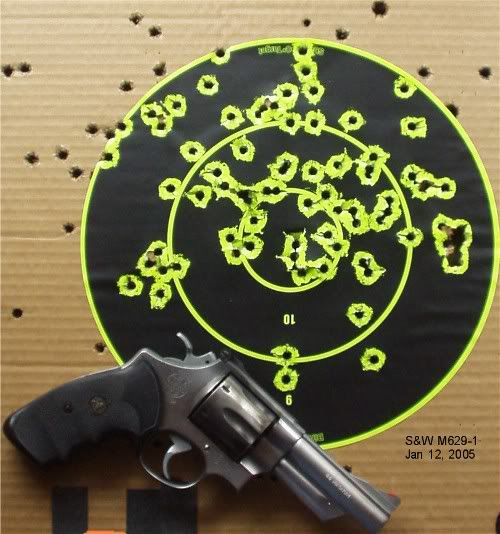 I liked it. It shot well. The recoil, while stouter than the guns I already had, wasn't so much. The only trouble, I couldn't comfortably shoot the gun double action (DA) without shifting my hand a bit so that I could reach the trigger.
I liked it. It shot well. The recoil, while stouter than the guns I already had, wasn't so much. The only trouble, I couldn't comfortably shoot the gun double action (DA) without shifting my hand a bit so that I could reach the trigger.Now, I'm not a tiny fellow. I'm average. 5 feet 8¼ inches tall and proportional, mostly. I should be able to do this. I tried to carry the gun daily but couldn't find a holster that I could wear that allowed me to carry the gun concealed. Frankly, that big cylinder is too much for me and IWB carry.
However, I killed a couple of groundhogs, one at 80 yards, and still liked the gun but hated the grips. Must be a better grip out there. So I bought a pair of Pachmayr's Compac Grippers. Because they don't cover the backstrap I thought that they'd let me reach the trigger for good DA shooting. Well it did that but the grips have very hard and square shoulders where the web of the hand meets the gun and when firing full-power .44 Mag loads it can hurt. Oh, one or two shots isn't bad. Might not be bad at all when adrenalized but, most shooting isn't done when you're hopped up on fear or excitement. One cylinderful was about all the fun I wanted.
For quite a while I was considering having the gun round-butted. That is, sending it to a smith who would convert the grip from square to round butt. I thought that might give me the reach my poor "little" hands needed to control the gun double action. It was suggested that I not worry about shooting the gun DA/self-cocking mode if it was so accurate. But, heck, it is a DA gun. Seems a waste to me to have a gun that good with that capability and not be able to use it! But, to be truthful, I was VERY frustrated. I've had this gun for so long and never really gotten to the point that it could be a daily companion. Of the cartridge I had no doubt, but the grips...
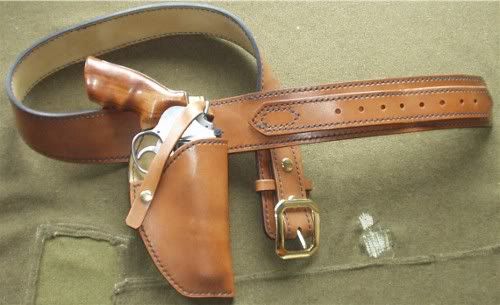 After some on-line inquiries I was clued in on the Hogue Auction site where Hogue auctions factory seconds and overstocks. Since I was looking for an inexpensive grip to try and had little faith this would be the "one" grip for this gun the prices were mighty attractive, especially when compared to retail. Shown here in a rig from Levergun Leather Works, these grips are very comfortable with full-house .44 Magnum loads and work well in DA.
After some on-line inquiries I was clued in on the Hogue Auction site where Hogue auctions factory seconds and overstocks. Since I was looking for an inexpensive grip to try and had little faith this would be the "one" grip for this gun the prices were mighty attractive, especially when compared to retail. Shown here in a rig from Levergun Leather Works, these grips are very comfortable with full-house .44 Magnum loads and work well in DA.The only problem is that they are slick. I find it difficult to thumb cock the hammer one-handed as the gun seems to be attempting to squirm right out of my hand!
I was so frustrated by now that I decided that a .45 Colt single-action revolver would work just as well for me and I got a Ruger New Vaquero 4-5/8" in just that chambering. This has become my daily carry gun (riding in the Simply Rugged Sourdough Pancake shown). It "sleeps" right beside my bed at night. But that isn't right, is it? I mean, I shouldn't ignore my 629.
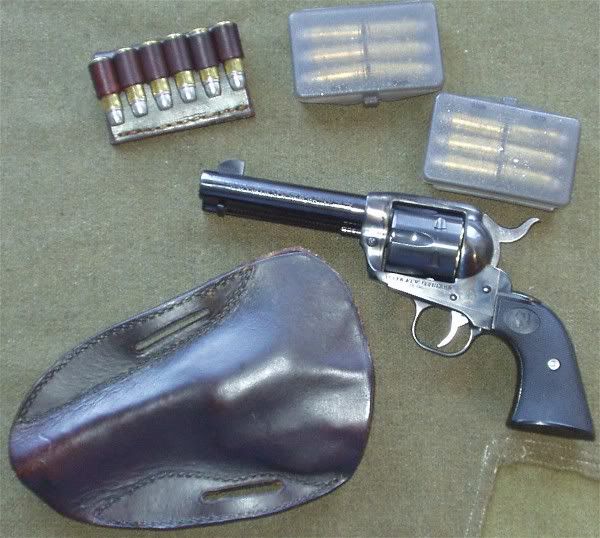 I didn't, I got a Sourdough for the 629 as well. It is a good holster in which either gun rides comfortably even doing heavy work! A really great holster at a very good price made by a wonderful fella.
I didn't, I got a Sourdough for the 629 as well. It is a good holster in which either gun rides comfortably even doing heavy work! A really great holster at a very good price made by a wonderful fella.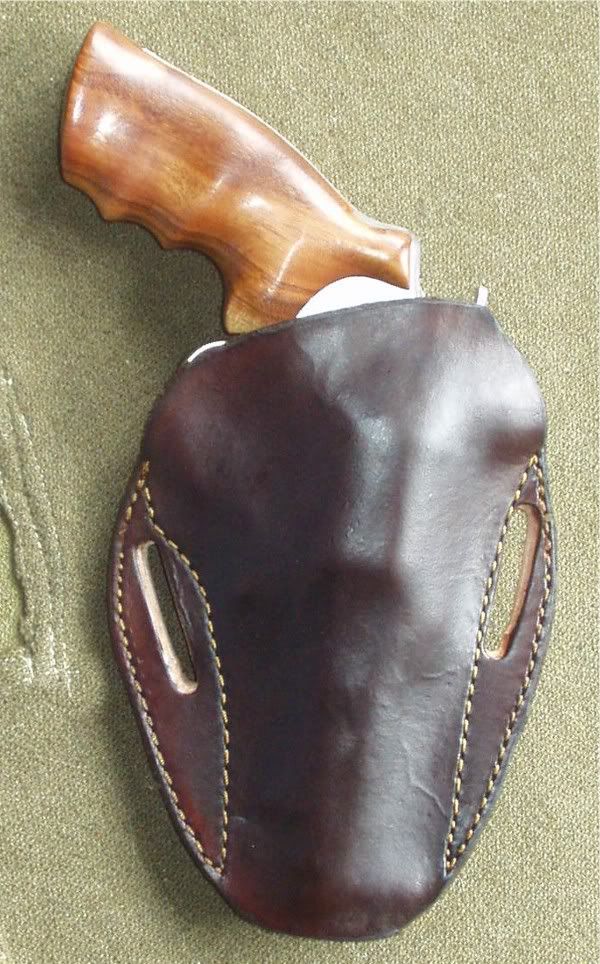 Still the grip size is a sticking point. I can't leave this revolver to waste away unwanted in the bottom of my safe, can I? No. So it now, once again, has a place by the bed and goes with me on my every-other-day excursions to Mom's place where it accompanies my mower rides and other chores and deals with the various varmints that I encounter. Still waiting on a coyote, but a couple of other 4-legged varmints have been hurried on their way to varmint heaven by the big .429 Hornady swaged SWC over 8 gr. of Unique. Both shots were taken double-action. I'm still working with it and perhaps there is hope yet for the big revolver.
Still the grip size is a sticking point. I can't leave this revolver to waste away unwanted in the bottom of my safe, can I? No. So it now, once again, has a place by the bed and goes with me on my every-other-day excursions to Mom's place where it accompanies my mower rides and other chores and deals with the various varmints that I encounter. Still waiting on a coyote, but a couple of other 4-legged varmints have been hurried on their way to varmint heaven by the big .429 Hornady swaged SWC over 8 gr. of Unique. Both shots were taken double-action. I'm still working with it and perhaps there is hope yet for the big revolver.
Subscribe to:
Comments (Atom)
